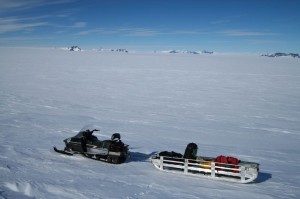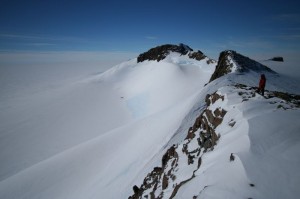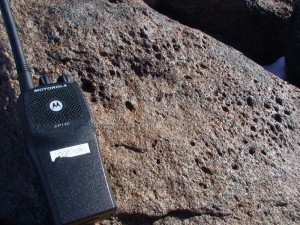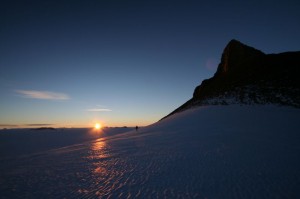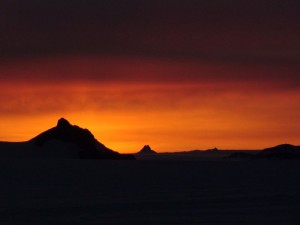More fieldwork – Lorentzenpiggen
I’m waaaaaaaaaay behind with writing some good posts about all the fieldwork that we did this summer, and so I’m just going to make some brief posts with pictures and maybe short descriptions to give a passing impression. I’ve just updated the post on the first trip (to Flarjuven, when we had to pull out due to bad weather) with some new photographs, so start there.
The next field trip was to the nearby nunatak of Lorentzenpiggen, which forms a distictive part of the skyline to the south of SANAE IV. The geomorphologists (aka ‘Geos’) wanted to survey the area for specific types of features. They have several research projects on the go, and are also collecting data for colleagues back in South Africa. Many of the nunataks have not been surveyed in detail by geomorrphs, so there was a element of exploration to the expedition. Nunantak lucky pack…
For Lorentzenpiggen we set out from SANAE IV on skidoos – myself and our Brazilian observer Ricardo Burgo (as field operator and assistant respectively), and geo’s Jay le Roux and Mike Loubser. Jay and Mike are great fun; both confident outdoorsmen but willing to accept guidance in the field; the former reserved, tall and thin and the latter ebullient and built like a taekwondo fighter (which he is). Burgo is a polymath spanning the fields of geology, geomorphology, glaciology, geographical information systems, etc, and a veteran of the Brazilian Antarctic programme, PROANTAR. He and a colleague, Lorena Collares, are being hosted by SANAP in Antarctica this season as part of the IBSA (India/Brazil/South Africa) scientific initiative. We very rapidly became friends, sharing the quirks of our countries and the parallel joys of science and Antarctica together. When he expressed a desire to get into the field to observe, I quickly roped him and his experience into the party.
Lorentzenpiggen (literally translated as Lorent’s Peak) is only half an hour’s skidoo ride from SANAE IV, so we kept the trip as a backup for when the weather opened but was not good enough for flying. The moment arrived after lunch one day, and as soon as the geo’s had finished baking some rocks for their mass-loss experiment we headed out in the early evening, executing a plan to establish camp and recce before sleeping over and using the whole of the subsequent day for gathering data.
Despite the proximity to the base, once on the southern side of ‘Piggen you feel wonderfully remote. We established camp in a sheltered depression and then rode around an obvious crevasse-field to where it was possible to access the eastern ridge of the mountain easily. Almost immediately the geo’s were excited, finding large areas of Tafoni weathering, one of their study subjects. As I learnt from them, Tafoni is a combined chemical and physical weathering process in which salt crystals form in the rock, causing pitting of the exposed surface. Reminiscent (for me) of emphysema in a smoker’s lungs, these small pits merge and deepen until (in advanced cases) the surface of the rock looks like Swiss cheese.
After deciding that the entire following day would be devoted to titillating Tafoni, we traversed around the main peak to overlook the crevasses and windscoops beyond. As it approached midnight we watched the beautiful sunset over the mountains in the south from the exposed ridge, knowing that sunrise was only an hour away. Down at the shaded camp I whipped up pasta to warm bellies and thence sleeping bags, and we turned in for the night. At ‘only’ -9C in my tent, I was glad of a thick down bag.
As planned, the next day for the geo’s was devoted to Tafoni, with Burgo and I doing all the support work. Essentially, we cooked up warm drinks and snacks for the other two, who had to manipulate small instruments on the exposed ridge in a brisk wind. We had a good view to SANAE, and could even hear the Kamov helicopter when it left to fly out a radio repeater to a hill between SANAE IV and Neumayer. The support turned south, however, when one of the skidoos decided that it would not start. Burgo and I fought and cursed the machine for a while – and did every field-service trick I have learned (changing and cleaning spark plugs, removing and checking air filters, de-icing the carbs, etc). Eventually, we gave up and resolved to tow it back to camp, from where we could tow to SANAE. Just before reaching the camp, I tried to start it one last time while being towed, and the blasted machine roared into life. We had to repeat the trick later to get back to SANAE, but it made the trip much more pleasant than towing all the way.
Next installment – fieldwork at the incredible Valterkulten Bluff – is being written now and will be published soon…
